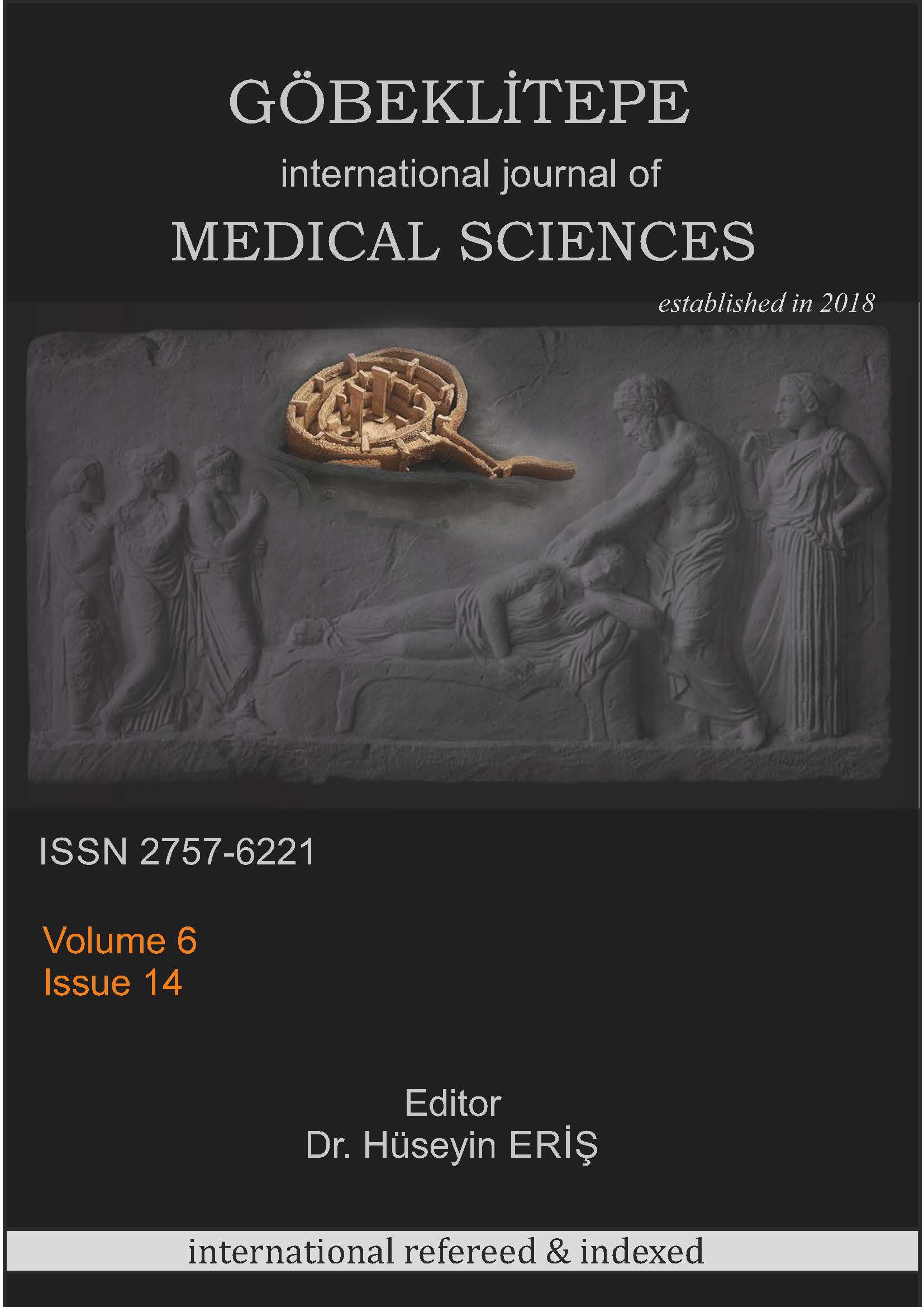ŞANLIURFA’DA ÜNİVERSİTE ÖĞRENCİLERİNİN İNTİHAR OLASILIKLARI VE İLİŞKİLİ FAKTÖRLER
DOI:
https://doi.org/10.55433/gsbd/234Anahtar Kelimeler:
Üniversite Öğrencisi, İntihar Olasılığı, ŞanlıurfaÖzet
Bu çalışmada üniversite öğrencilerinin intihar, intihar düşüncesi ve bunlarla ilgili hazırlayıcı faktörlerin belirlenmesi amaçlanmıştır. Kesitsel tipte olan bu araştırmanın örneklemini bir üniversitede öğrenim gören 1 Ekim 2022-1 Ocak 2023 tarihleri arasında ulaşılan 1451 öğrenci oluşturmaktadır. Veriler, araştırmacılar tarafından hazırlanan sosyo-demografik bilgi formu ve İntihar Olasılığı ölçeği (SPS) kullanılarak online toplanmıştır. Öğrencilerin intihar olasılığı ölçeğinden toplam aldıkları puan ortalaması 73.53±17.41 hesaplanırken, alt boyutlarında ise umutsuzluk alt boyutu 26.55±7.10, intihar düşüncesi alt boyutu 12.19±3.75, düşmanlık alt boyutu 12.21±3.75 ve olumsuz kendilik değerlendirmesi alt boyutu 22.5±5.50 olarak hesaplanmıştır. Aylık geliri 1000 tl ve altında olanların, sigara ve madde kullananların, psikiyatrik öyküsü olanların, daha önce intihar girişiminde bulunanların, ailesi veya çevresinde intihar girişiminde bulunanların, psikiyatrik ilaç kullananların, daha önce taciz veya istismara maruz kalanların intihar olasılığı ölçeği toplam puanın daha yüksek olduğu görülmüştür (p˂0.05). Üniversite öğrencilerinde intihar olasılığının ele alınması, ruh sağlığı açısından periyodik taramaların yapılması üniversite öğrencilerine yönelik sunulacak koruyucu ruh sağlığı hizmetlerinin planlanmasında katkı sağlayacaktır.
Referanslar
REFERENCES
Crosby, A., Ortega, L., & Melanson, C. (2011). Self-directed violence surveillance; uniform definitions and recommended data elements, Version 1.0. Atlanta (GA): Centers for Disease Control and Prevention. National Center for Injury Prevention and Control
Posner, K., Melvin, G. A., & Stanley, B. (2007). Identification and monitoring of suicide risk in primary care settings. Primary Psychiatry, 14(12), 50.
Murray, C. J., Aravkin, A. Y., Zheng, P., Abbafati, C., Abbas, K. M., Abbasi-Kangevari, M., ... & Lim, S. S.. (2020). Global burden of 87 risk factors in 204 countries and territories, 1990–2019: a systematic analysis for the Global Burden of Disease Study 2019. The lancet, 396(10258), 1223-1249.
World Health Organization (WHO). Suicide worldwide in 2019. (2021). https://www.who.int/publications/i/item/9789240026643
Turkish Statistical Institute (TÜİK). By Statistical Territorial Units Classification and by gender. (2023). https://data.tuik.gov.tr/Bulten/Index?p=Olum-ve-Olum-Nedeni-Istatistikleri-2020.
Bosson, J. K., Vandello, J. A., & Buckner, C. E. (2019). The psychology of sex and gender. SAGE Publications. Thousand Oaks, California.
The American Foundation for Suicide Prevention (AFSP). Suicide Statics (2021). https://afsp.org/suicide-statistics/
Centers for Disease Control and Prevention (CDC). National Vital Statistics System, Mortality 2018-2021 (2023).. http://wonder.cdc.gov/mcd-icd10-expanded.html
Ültanır, E. (1996). The Necessity of Opening Psychological Counseling and Guidance Centers in Newly Opened Universities, Çağdaş Eğitim Dergisi, 220, 10-14.
Kessler, R. C., Amminger, G. P., Aguilar-Gaxiola, S., Alonso, J., Lee, S., & Ustün, T. B. (2007). Age of onset of mental disorders: a review of recent literature. Current opinion in psychiatry, 20(4), 359–364.
Uchida, C., & Uchida, M. (2017). Characteristics and risk factors for suicide and deaths among college students: A 23-year serial prevalence study of data from 8.2 million Japanese college students. The Journal of clinical psychiatry, 78(4), 2512.
Li, W., Dorstyn, D. S., & Jarmon, E. (2020). Identifying suicide risk among college students: a systematic review. Death studies, 44(7), 450-458.
Atlı, Z., Eskin, M., & Dereboy, Ç. (2009). The Validity and the Reliliability of Suicide Probability Scale (SPS) in Clinical Sample. Turkish Journal of Clinical Psychiatry, 12(3), 111-124
Liu, C.H., Stevens, C., Wong, S.H.M., Yasui, M., & Chen, J.A. (2019). The prevalence and predictors of mental health diagnoses and suicide among U.S. college students: Implications for addressing disparities in service use. Depress Anxiety, 36(1), 8-17.
Wu, R., Zhu, H., Wang, ZJ.., & Jiang, CçL. (2021). A Large Sample Survey of Suicide Risk among University Students in China. BMC Psychiatry, 21(1), 474.
Nock, M.K., Borges, G., Bromet, E.J., Alonso, J., Angermeyer, M., Beautrais, A., Bruffaerts, R., Chiu, W.T., de Girolamo, G., Gluzman, S., de Graaf, R., Gureje, O., Haro, J.M., Huang, Y., Karam, E., Kessler, R.C., Lepine, J.P., Levinson, D., Medina-Mora, M.E., Ono, Y., Posada-Villa, J. &Williams, D. (2008) Cross-national prevalence and risk factors for suicidal ideation, plans and attempts. The British Journal of Psychiatry, 192, 98-105.
Ceyhun, A. G., & Ceyhun, B. (2003). Evaluation of suicide probability in high school and university students. Turkish Journal of Clinical Psychiatry, 6(2), 217-224.
Aslan, B., & Durak, Batıgün, A., (2017). The Mediating Role of Life Goals in the Relationship Between Parent Acceptance/Rejection and Suicide Probability. Turkish Journal of Psychology, 32(79), 77–79.
Jones, L. B., Vereschagin, M., Wang, A. Y., Munthali, R. J., Pei, J., Richardson, C. G., Halli, P., Xie, H., Rush, B., Yatham, L., Gadermann, A. M., Pendakur, K., Prescivalli, A. P., Munro, L., Bruffaerts, R., Auerbach, R. P., Mortier, P., & Vigo, D. V. (2022). Suicidal Ideation Amongst University Students During the COVID-19 Pandemic: Time Trends and Risk Factors. Canadian journal of psychiatry, Epub ahead of print. 7067437221140375.
Sousa, GS., Ramos, BMD., Tonaco, LAB., Reinaldo, AMDS., Pereira, MO., & Botti, NCL. (2021). Factors associated with suicide ideation of healthcare university students. Rev Bras Enferm. 75(3), e20200982. English, Portuguese.
Toprak, S., Cetin, I., Guven, T., Can, G., & Demircan, C. (2011). Self-harm, suicidal ideation and suicide attempts among college students. Psychiatry research, 187(1-2), 140-144.
Aries, E., & Seider, M. (2007). The role of social class in the formation of identity: A study of public and elite private college students. The Journal of Social Psychology, 147(2), 137–157.
Cho, MS. (2020). Use of Alcohol, Tobacco, and Caffeine and Suicide Attempts: Findings From a Nationally Representative Cross-sectional Study. J Prim Care Community Health. 11, 2150132720913720.
Kaslow, N. J., & Marshall Lee, E. D. (2010). Suicidal Behavior Among Youth. The Corsini Encyclopedia of Psychology, 1-3.
Abdu, Z., Hajure, M., & Desalegn, D. (2020). Suicidal behavior and associated factors among students in Mettu University, South West Ethiopia, 2019: an ınstitutional based cross-sectional study. Psychol Res Behav Manag, 3, 233-243.
Gürhan, N., Meriç, M., Kaya, B., Turan, Nd., & Kabataş, Esra. (2018) Comparison of suicide probability and problem solving levels of faculty of medicine and nursing students according to socio-demographic variables Gümüşhane University Journal Of Health Sciences GUSBD, 7(1), 149-155
Gould, M., Greenberg, T., Velting, DM., & Shaffer, D. (2003). Youth suicide risk and preventive interventions: a review of the past 10 years. J Am Acad Child Adolesc Psychiatry, 4, 386-402.
Qaddoura, N., Dardas, LA., & Pan, W.(2022). Psychosocial determinants of adolescent suicide: A national survey. Arch Psychiatr Nurs. 40, 15-24.
O'Neill, S., Mc Lafferty, M., Ennis, E., Lapsley, C., Bjourson, AJ., Armour, C., Murphy, SD., Bunting, B., & Murray, EK. (2018). Socio-demographic, mental health and childhood adversity risk factors for self-harm and suicidal behaviour in College Students in Northern Ireland. Journal of Affective Disorders, 239, 58-65. [JAD9849].
Liu, H., Wang, W., Qi, Y., & Zhang, L. (2022). Suicidal ideation among Chinese survivors of childhood sexual abuse: Associations with rumination and perceived social support, Child Abuse & Neglect, 105420,
Thompson, A. E., & Kaplan, C. A. (1996). Childhood emotional abuse. British Journal of Psychiatry, 168, 143-148.
İndir
Yayınlanmış
Sürüm
- 2024-07-02 (2)
- 2023-12-24 (1)
Nasıl Atıf Yapılır
Sayı
Bölüm
Lisans
Telif Hakkı (c) 2023 Göbeklitepe Sağlık Bilimleri Dergisi

Bu çalışma Creative Commons Attribution 4.0 International License ile lisanslanmıştır.




